
Addition (Basic)
Addition (Multi-Digit)
Algebra & Pre-Algebra
Comparing Numbers
Daily Math Review
Division (Basic)
Division (Long Division)
Hundreds Charts
Measurement
Multiplication (Basic)
Multiplication (Multi-Digit)
Order of Operations
Place Value
Probability
Skip Counting
Subtraction
Telling Time
Word Problems (Daily)
More Math Worksheets
Reading Comprehension
Reading Comprehension Gr. 1
Reading Comprehension Gr. 2
Reading Comprehension Gr. 3
Reading Comprehension Gr. 4
Reading Comprehension Gr. 5
Reading Comprehension Gr. 6

Reading & Writing
Reading Worksheets
Cause & Effect
Fact & Opinion
Fix the Sentences
Graphic Organizers
Synonyms & Antonyms
Writing Prompts
Writing Story Pictures
Writing Worksheets
More ELA Worksheets
Consonant Sounds
Vowel Sounds
Consonant Blends
Consonant Digraphs
Word Families
More Phonics Worksheets
Early Literacy
Build Sentences
Sight Word Units
Sight Words (Individual)
More Early Literacy
Punctuation
Subjects and Predicates
More Grammar Worksheets
Spelling Lists
Spelling Grade 1
Spelling Grade 2
Spelling Grade 3
Spelling Grade 4
Spelling Grade 5
Spelling Grade 6
More Spelling Worksheets
Chapter Books
Charlotte's Web
Magic Tree House #1
Boxcar Children
More Literacy Units
Animal (Vertebrate) Groups
Butterfly Life Cycle
Electricity
Matter (Solid, Liquid, Gas)
Simple Machines
Space - Solar System
More Science Worksheets
Social Studies
Maps (Geography)
Maps (Map Skills)
More Social Studies
Mother's Day
Father's Day
More Holiday Worksheets
Puzzles & Brain Teasers
Brain Teasers
Logic: Addition Squares
Mystery Graph Pictures
Number Detective
Lost in the USA
More Thinking Puzzles
Teacher Helpers
Teaching Tools
Award Certificates
More Teacher Helpers
Pre-K and Kindergarten
Alphabet (ABCs)
Numbers and Counting
Shapes (Basic)
More Kindergarten
Worksheet Generator
Word Search Generator
Multiple Choice Generator
Fill-in-the-Blanks Generator
More Generator Tools
Full Website Index
Proofreading Editing Worksheets
Printable proofreading worksheets for building grammar, spelling, and writing skills. Each file has a short paragraph on it. Students read carefully and look for errors in capitalization, spelling, and punctuation.
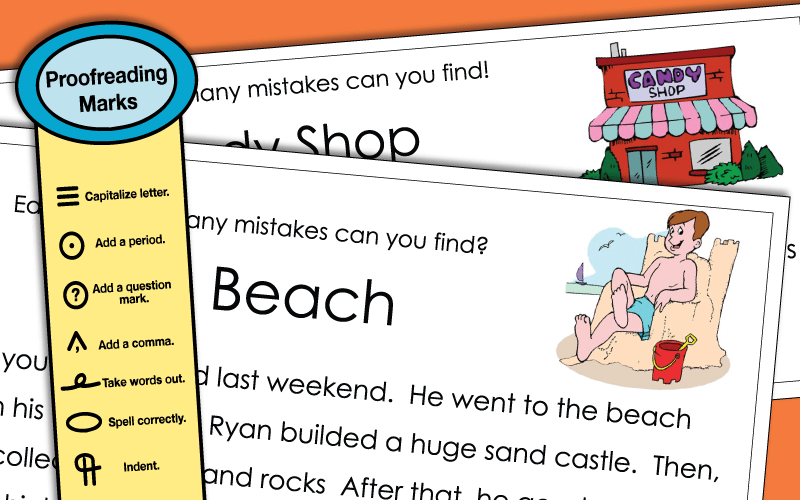
Editing Passages

Logged in members can use the Super Teacher Worksheets filing cabinet to save their favorite worksheets.
Quickly access your most used files AND your custom generated worksheets!
Please login to your account or become a member and join our community today to utilize this helpful feature.

Manipulative Editing Wheels
Proofreading bookmarks.
Correct the errors in the sentences. This series can be used as a daily or weekly review, or use the individual worksheets for extra practice.
These worksheets feature practice with periods, question marks, exclamation points, commas, and quotation marks.
Worksheets for sentences, nouns, verbs, adjectives, adverbs, pronouns, and more.
Worksheet Images
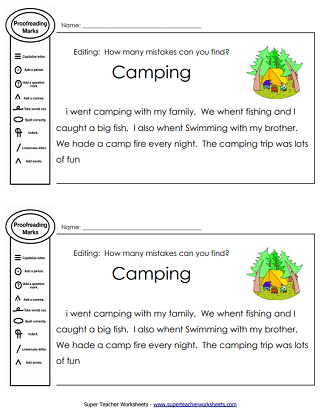
PDF with answer key:
PDF no answer key:
- Readers Read
- Screenwriting
- Songwriting
- Writing Contests
Karlie Kloss to Relaunch Life Magazine at Bedford Media
NBF Expands National Book Awards Eligibility Criteria
Striking Writers and Actors March Together on Hollywood Streets
Vice Media Files for Chapter 11 Bankruptcy
Oprah Selects The Covenant of Water as 101st Book Club Pick
- Self-publishing
- Technical Writing
- Writing Prompts
- Skip to primary navigation
- Skip to main content
- Skip to primary sidebar
Teaching Expertise
- Classroom Ideas
- Teacher’s Life
- Deals & Shopping
- Privacy Policy
19 Activity Ideas For Precise Proofreading
February 9, 2023 // by Rebecca Przy
Proofreading and editing are important parts of the writing process. When I start writing something, my initial priority is the content. I save the finetuning of spelling, punctuation, and grammar for the final stages. Proofreading is key for this!
As your students begin learning how to write; from journal entries to essays, incorporating proofreading is a crucial component for clear and effective writing. Here are 19 activity ideas for students of all ages to practice their proofreading skills!
1. Daily Proofreading Practice (K – Grade 2)
The more your students practice, the better their proofreading abilities will be. Here are some pre-made writing slips which will encourage younger students to practice their capitalization, spelling, punctuation, and grammar rules.
Learn More: Teachers Pay Teachers
2. Sentence Experts (Grades 1 – 3)
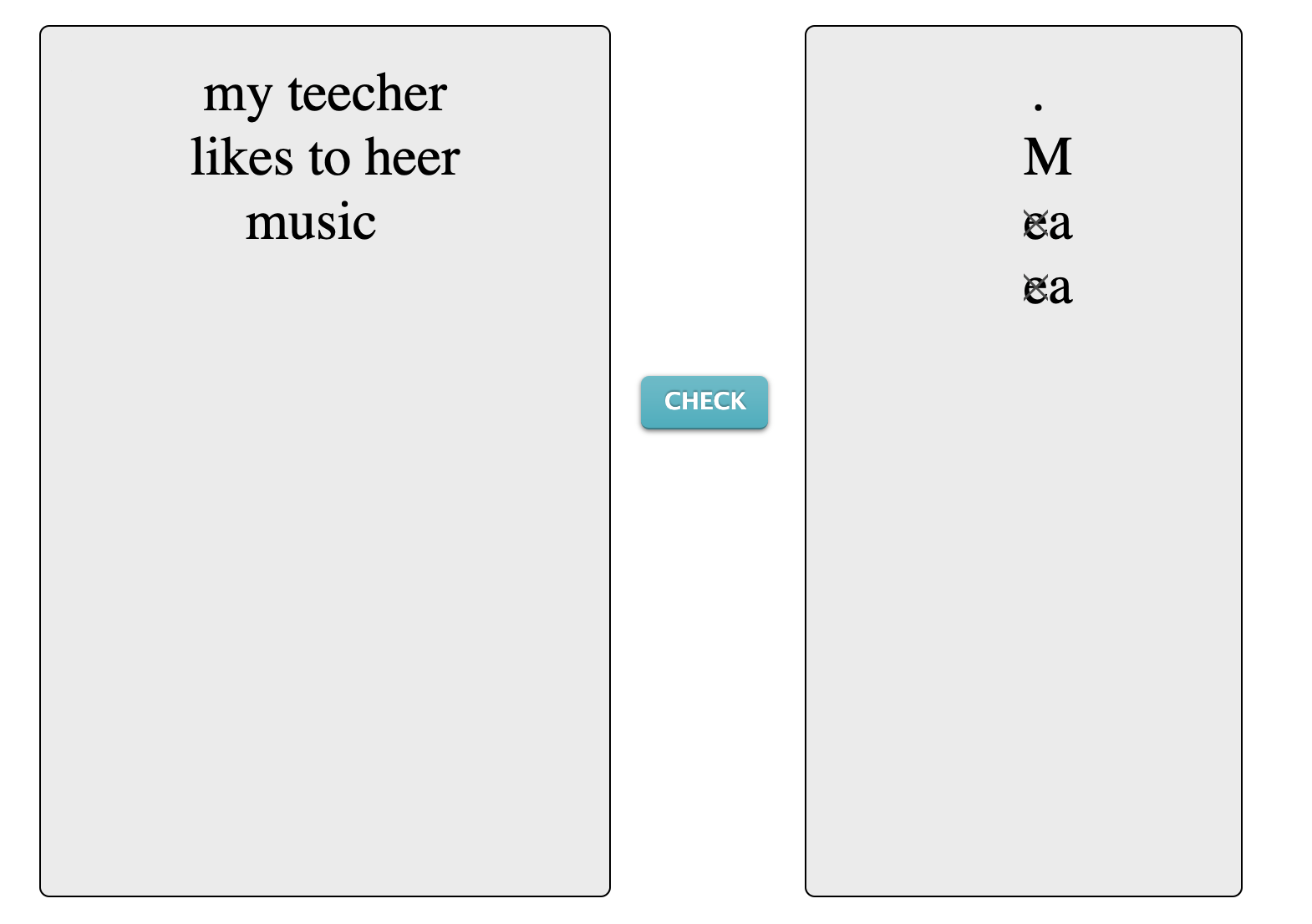
Online games can be a great way for your students to have fun practicing their language skills at home. This activity involves sentence-level editing. Your students can drag and drop the characters to correct the errors.
Learn More: Mr. Nussbaum
3. Editing Passages: Whole Class Activity (Grades 1 – 6)
Here’s a great editing practice for the whole class. The goal is to identify mistakes in a written passage on the board. You can throw a ball to a student who must identify an error within a given time limit. If they cannot, a new student tries.
Learn More: Teach Starter
4. Proofreading: Basketball (Grades 2 – 4)

Do any of your students like basketball? Choosing stories with topics that your students are interested in can make the editing process that much more enjoyable. Through proofreading this story, your students can also learn how to use the correct proofreading symbols.
Learn More: Super Teacher Worksheets
5. Proofreading: The Beach (Grades 2 – 4)

If your students aren’t big into basketball, you could try this passage about the beach. These short paragraphs make excellent proofreading practice for younger elementary students.
6. Proofreading Cards (Grades 3 – 5)
This proofreading activity includes 20 cards with different spelling or grammar errors. Your students can examine the sentences, record their corrections on the answer sheet, and then compare them with their peers!
Learn More: Sadlier School
7. Irregular Verbs: My Journey to Manchester (Grade 3 – 5)

This passage about a train journey contains a variety of errors regarding verb tense. Through this worksheet, learners can practice identifying these errors and correcting them. Should it be past or present tense?
Learn More: ISL Collective
8. Irregular Verbs: A Sightseeing Holiday in Paris (Grades 3 – 5)
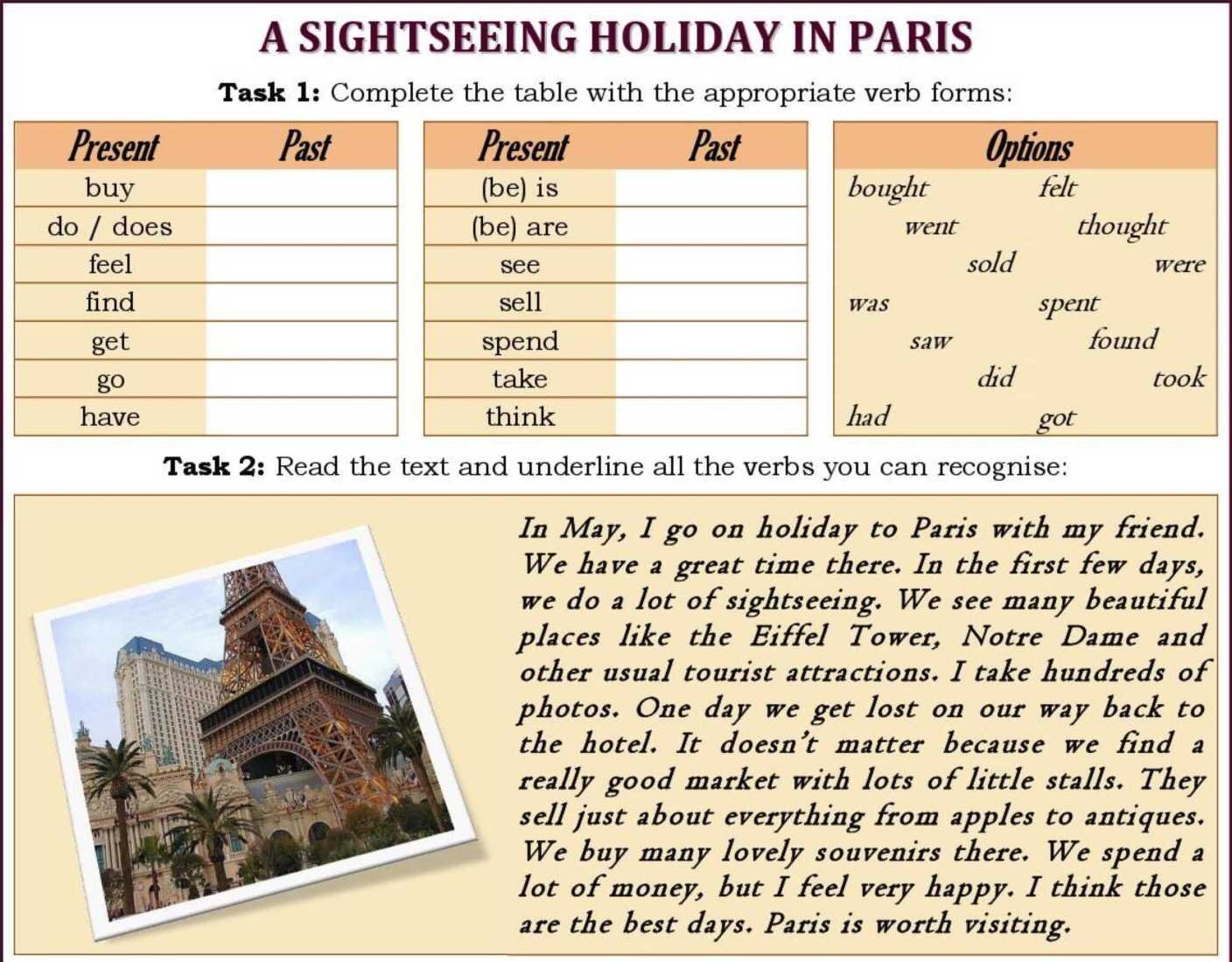
Here’s another flawed piece of writing that your students could use to develop their verb tense understanding. Their writing could improve by using these editing worksheets and remembering to use the correct verb forms.
9. Paragraph Proofreading (Grades 4 – 6)
Here are some engaging writing pieces for upper elementary students. Your students can try reading through these paragraphs while checking for various mistakes, including comma errors, capitalization errors, and others. Each passage includes an editing checklist!
Learn More: The Butterfly Teacher
10. Extreme Sentence Surgeons (Grades 4 – 6)

This is a surgery-style online game that gets your students to rescue and fix the severely “injured” paragraphs. The paragraphs are ridden with many common and glaring errors. Are your students’ editing skills keen enough to help?
11. Musical Papers: Peer Editing Activity (Grades 5 – 9)
You’ve probably heard of musical chairs, but what about musical papers? Students walk around each others’ tables while music is playing. Once the music stops, your students can stop and edit the work at the nearest desk. Each round can involve different aspects of proofreading.
Learn More: Markers and Minions
12. Spell Checker Worksheet (Grades 6 – 8)
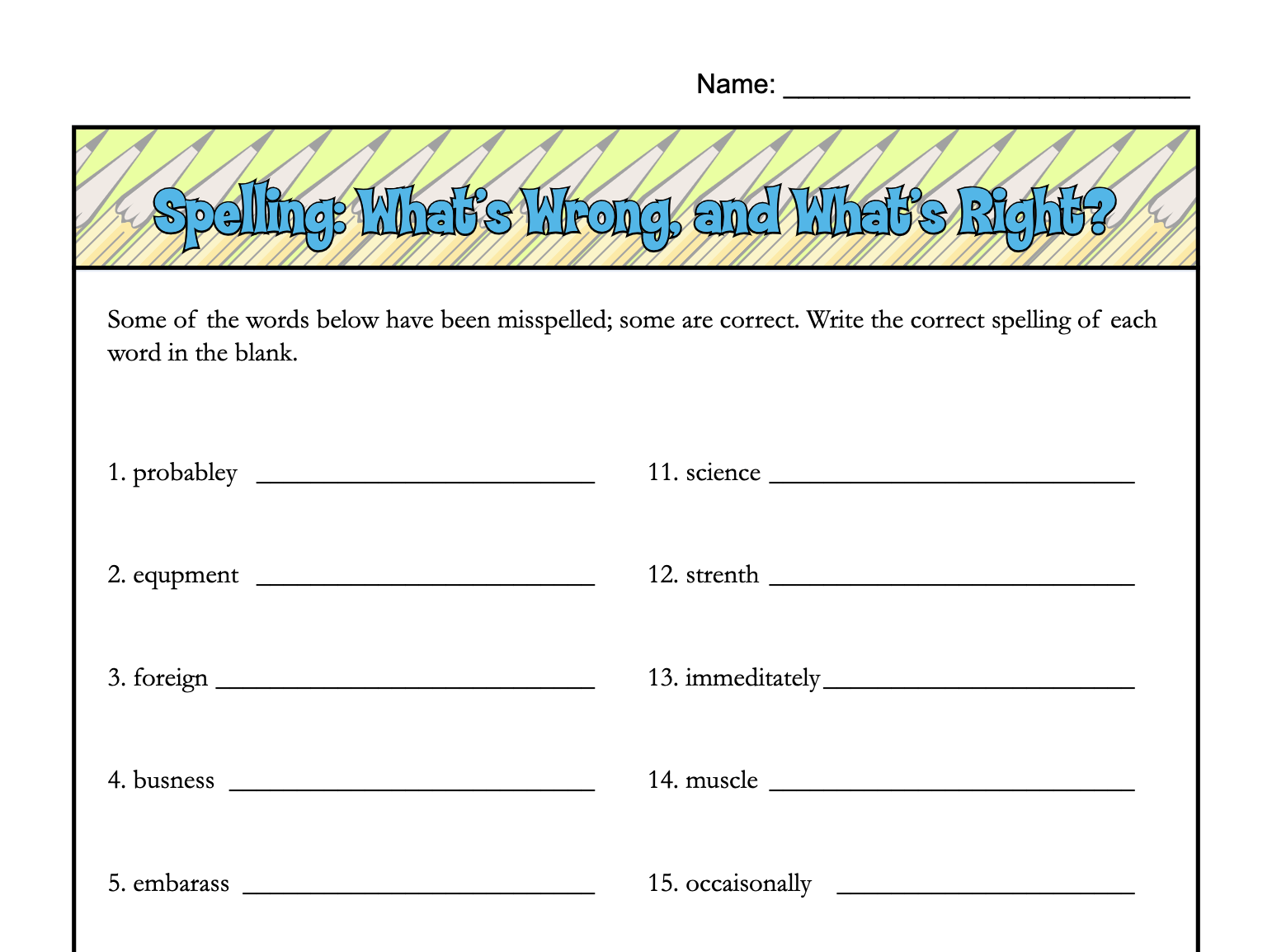
Incorrect spelling is such a common error in my students’ writing. Practicing spelling can improve your students’ editing skills and make for a more efficient writing process. These worksheets contain a mix of correct and incorrect commonly misspelled words for your students to correct.
Learn More: K12 Reader
13. Proofread Celebrity Social Media (Grade 6 – 9)
It might be more fun to practice proofreading using a celebrity’s casual social media posts versus more formal writing. In this activity, your students can correct and re-write the social media posts. Then, they can provide the reasoning behind their edits.
Learn More: Presto Plans
14. Proofread Music Lyrics (Grades 7 – 10)
Like social media posts, the music that these celebrities make can also contain various grammatical errors. Similar to the last activity, your students can revise the lyrics and then explain their revisions.
15. Grammar Bell Ringer (Grade 9 – 12)
Bell ringers can make a great class transition activity for older kids who are juggling multiple courses in a day. This 10-minute activity consists of sentences with a variety of errors that your students can try to fix.
Learn More: Julie Faulkner’s Blog
16. Language Arts Bell Ringers (Grade 9 – 12)
You can download this free 4-week set of language arts bell ringers for your secondary students. The Monday bell ringers are most relevant to proofreading as your students would have to correct the errors in a piece of writing.
Learn More: The Secondary English Coffee Shop
17. Paragraph Correction
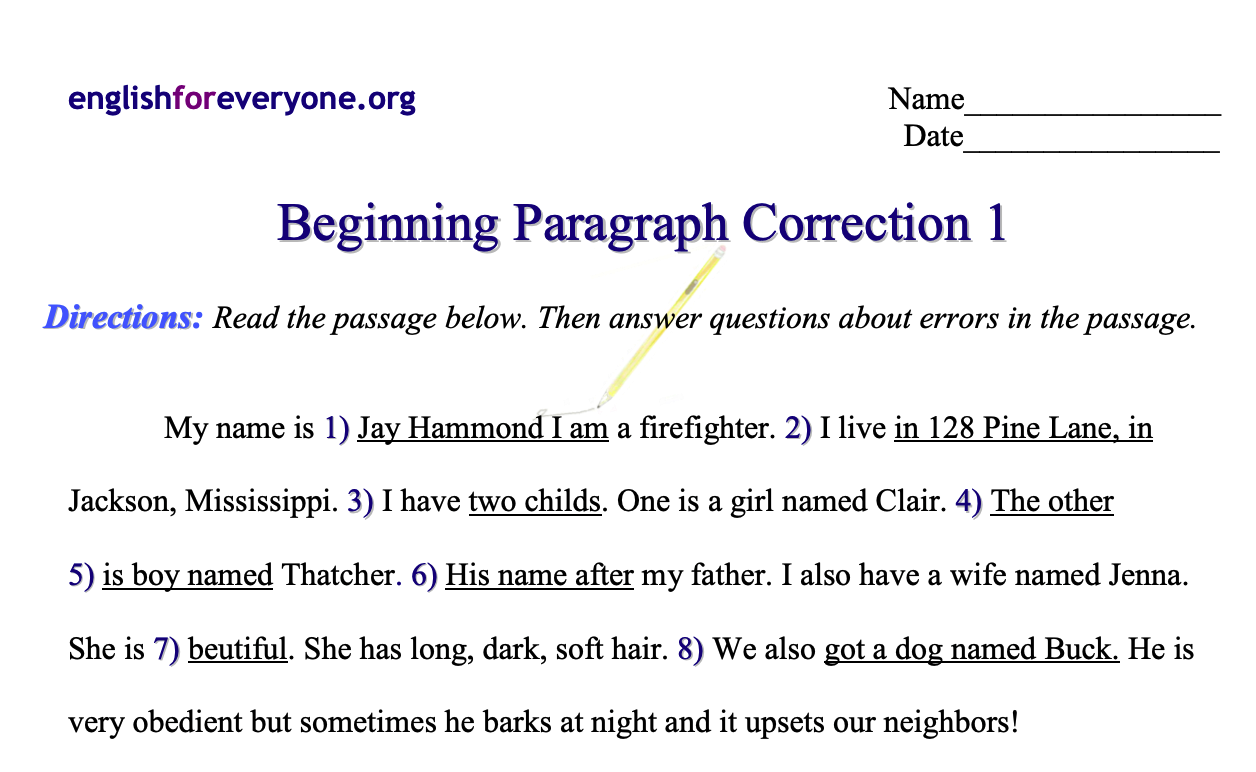
This resource has a list of free paragraph correction worksheets for beginner, intermediate, and advanced levels. The passages contain many kinds of errors, including grammar, spelling, and punctuation errors for your students to practice proofreading.
Learn More: English For Everyone
18. COPS Checklist
Editing checklist tools can be great for detecting a variety of errors before your students submit their final draft of writing. This checklist looks for correct capitalization, proper organization, punctuation errors, and spelling errors (COPS).
19. More Checklists
These additional editing checklists can be used to evaluate the content of more specific types of writing, such as narrative or persuasive writing. This bundled resource also includes basic spelling, grammar, and punctuation checklists.

Proofreading Exercises
Learn how to proofread by working through our library of proofreading exercises.
- Post author By Duncan Croker
- Post date August 24, 2020
- 4 Comments on Proofreading Exercises
Explore the Blog
- Content Writing
- Copywriting
- Email Marketing
- Hospitality & Leisure
- Legal Services
- Marketing Agencies
- Pharmaceuticals & Medical Products
- Photography
- Real Estate & Property
- Social Media
- The Arete Letter
- Website Development
Recent Posts
- How to Choose the Right Marketing Vendor for Your Law Firm February 10, 2024
- TAL. 025: How to Create a Live SEO Report December 11, 2023
- TAL. 024: How to De-Risk Risky Content Decisions December 4, 2023
Search Our Blog
Bookmark this page – we upload new proofreading exercises regularly.
- Easy Exercises
- Medium Exercises
- Hard Exercises
In a digital world, it’s more important than ever to make sure your communications are error-free – you don’t want to be responsible for a press release that goes viral because of an awkward misspelling.

That’s why we’ve put together this collection of proofreading exercises to test your skills. Work your way up through the difficulty levels until you feel confident that you’ve mastered the required proofreading skills.
Download each exercise PDF to get started, then print it out or copy-paste it into Microsoft Word; once you’ve finished editing, cross-check the mistakes you found with the relevant answer sheet.
Answer sheets follow AP Stylebook conventions (where appropriate) and use British spelling. New proofreading exercises will be regularly added to this page. Note that the original sources contain the correct text – all mistakes have been added in for the purposes of the exercises.
Easy Proofreading Exercise 1
Exercise details.
Format: News Article
Source: ‘NSW Transport Minister Andrew Constance hits back after claims Sydney ferries won’t fit under bridges.’
Easy Proofreading Exercise 2
Source: ‘Now is the time to buy in the Melbourne property market.’
Easy Proofreading Exercise 3
Format: Blog Post
Source: How to Find the Noosa Fairy Pools
Easy Proofreading Exercise 4
Source: Marketing for Small Businesses
Medium Proofreading Exercise 1
Format: Annual Report
Source: Rio Tinto Annual Report 2019 – Strategic Report
Medium Proofreading Exercise 2
Source: The 11 Best Foods to Support Your Immune System
Medium Proofreading Exercise 3
Format: Online Article
Source: A Better Way to Map Brand Strategy
Medium Proofreading Exercise 4
Format: Online Publication
Source: Telstra s 87B Undertaking
Tactical Marketing Tips, Weekly
Sign up to The Arete Letter for one tactical marketing recommendation delivered to your inbox every week.
Read past issues here
Hard Proofreading Exercise 1
Format: Academic Journal
Source: Passafaro, P. (2020). Attitudes and Tourists’ Sustainable Behavior: An Overview of the Literature and Discussion of Some Theoretical and Methodological Issues. Journal of Travel Research, 59 (4), 579–601. DOI: 10.1177/0047287519851171
Hard Proofreading Exercise 2
Source: Demirkol, S., & Cifci, I. (2020). Delving into the Role of Celebrity Chefs and Gourmets in Culinary Destination Marketing. European Journal of Tourism Research, 26 , 2603. https://ejtr.vumk.eu/index.php/about/article/view/1934
Other Resources for Improving Your Proofreading

- Tags Proofreading
By Duncan Croker
Duncan is a copywriter with a background in editing and storytelling. He loves collaborating with brands big and small, and thrives on the challenges of hard marketing.
4 comments on “Proofreading Exercises”
This is great. It’s really helpful to see practical exercises. Thanks for putting this together!
Fantastic exercises, thank you for providing these!
These exercises have been really great. Thank you. I’m using them with my A level student in preparation for University where proofreading will be essential! The content is just right for his interest level too and short enough to keep his interest.
Hi Geraldine, it’s great to hear you and your student are finding the exercises helpful. We’ll hopefully add some more in the near future.
Comments are closed.

Top-Tier Proofreading Tests and Quizzes (over 450!)
This article may contain affiliate links. Please see our affiliate disclaimer in the footer menu for more information. Thank you for your support!

I’ve scoured the internet to bring you some of the best online proofreading tests and quizzes!
I recommend using a dictionary and other resources while taking these tests since professional proofreaders use resources while working. In fact, we couldn’t do our job without them!
Below, you’ll find helpful information about the assessments. I’ve tried to order them from easiest to hardest.
At the beginning, I’ve included a test I made to get the ball rolling!
Two tests are in UK English, and the rest are in US English.
Please keep in mind that there are spelling, punctuation, grammar, and vocabulary differences between British and American English.
The duration of the test is listed as short or long.
Short means it will probably take you a few minutes to complete. Long just means it will probably take you more than a few minutes to finish; “long” really isn’t very long. Is that vague enough for you, lol?
I’ve included the number of quizzes on each website whenever more than one quiz is available. Some of these websites will probably add more tests over time.
I hope you have fun testing your skills and boosting your proofreading power! 😊
Om Proofreading
Test Format: Multiple choice
Type of English: US
Duration: Long
Test-Taking Note: This test focuses on mistakes that spellcheckers miss. Most sentences deal with homophones: words that have the same pronunciation but different meanings (and often different spellings). I hope you enjoy it!
Note: If you need to rid your writing (or someone else’s) of mistakes with homophones, the free version of Grammarly can catch a lot of homophonic errors!
And if you aced the test above, you may want to check out my article about confusing homophones . It contains a fun quiz at the end to check your understanding!
Edit Republic
Quiz Format: Multiple choice
Type of English: US
Duration: Short
What the Company Offers: Site owner Phon Baillie has 20 years of experience in the publishing industry. She offers several courses for those interested in working as proofreaders or editors.
Portland Proof
Quiz Format: Find the error in each sentence and write the correct word or punctuation mark in the text box
Duration: Short; I’m not sure how many quizzes are on this site, but it seems to have quite a few. I think they’re a ton of fun!
Quiz-Taking Tip: Click the “Begin Game!” button to start the quiz. Your score is based on how many mistakes you make and how long it takes you to correct each sentence. You can compete with other quiz takers for the highest score.
What the Company Offers: This company provides proofreading services.
GrammarBook.com
Test/Quiz Format: Multiple choice; 4 tests and 52 quizzes are available
Duration: Long (the 2 pretests and 2 mastery tests); Short (the other 52 quizzes)
What the Company Offers: This website is based on Jane Straus’s The Blue Book of Grammar and Punctuation . I own and love this book!
The site is a fantastic resource for proofreaders and copy editors as it teaches the rules for English grammar, punctuation, and usage. It includes 4 free tests and 52 free quizzes. Hundreds of additional quizzes are available with a paid subscription.
Grammar Monster

Test Format: Varies
Duration: Short (334 total tests!!!)
What the Company Offers: This site provides a wealth of knowledge about grammar, punctuation, and commonly misused words. And, of course, truckloads of tests are available. You can hone your English language skills to your heart’s content!
Quiz Format: Find the error in each sentence
Type of English: Not a relevant factor in this case (but UK punctuation is used)
Duration: Long
Quiz-Taking Tip: You have to click on the correct answer (located in the word bank below each sentence).
What the Company Offers: Sporcle provides trivia entertainment online and at live shows. If you’re into trivia, you’ll love this site!
BusinessWritingBlog
Test Format: Find the punctuation error in each sentence
What the Company Offers: This company is dedicated to helping people become experts in business writing.

Proofread NOW .com
Quiz-Taking Tip: As soon as you click inside the bubble to mark your answer, the quiz moves on, and you can’t go back.
What the Company Offers: Proofreading and copyediting for documents written in English and Spanish; English-to-Spanish and Spanish-to-English translation services
Employment for Proofreaders: Yes. However, they weren’t hiring the last time I checked. They require a minimum of five years of experience as a professional proofreader. You must also perform exceptionally well on several complicated editing tests.
You can go here to see if they’re currently hiring.
Grammar Lion
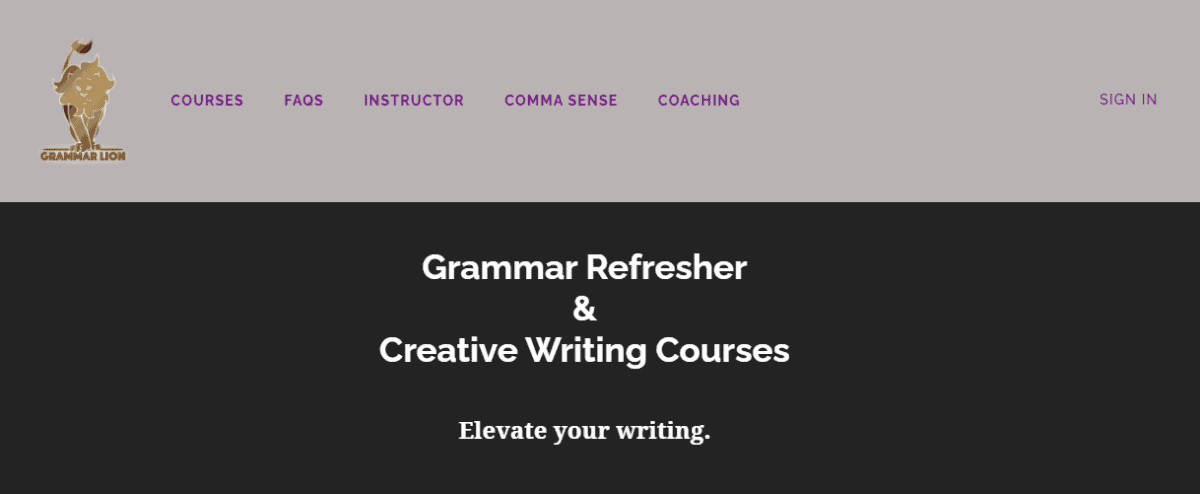
Test Format: Multiple choice
Duration: Short
Test-Taking Note: You need to create an account to access this free test. I took it and enjoyed it! You can take the test now and then retake it after finishing the Grammar Lion Refresher class to see how much you’ve learned.
Test-Taking Tip: You can’t go back on any questions, so make sure you’re happy with your answer before moving on. After finishing the test, choose “Next Lesson” to see your score.
What the Company Offers: Site owner Ellen Feld has a master’s degree in writing from Johns Hopkins University. She offers a grammar course and a writing course, both suitable for beginners. Ellen also provides coaching services for writers.
The Chartered Institute of Editing and Proofreading (CIEP)
Test Format: Finding errors in a passage of text
Type of English: UK
Test-Taking Note: One question requires a bit of copyediting
What the Company Offers: The CIEP is a nonprofit organization that puts forth editorial standards. They serve as a community that provides support and training to people working in the editorial profession. They have useful resources and offer unique benefits to paying members.
CMOS Shop Talk (from The Chicago Manual of Style )
Workout Format: Multiple choice; 47 workouts are available
Workout Tip: Remember to breathe deeply and engage your core. Oops! I mean, enjoy this fabulous resource! These workouts mainly contain questions related to proofreading; however, they also include questions about editing and knowledge of The Chicago Manual of Style (CMOS).
I own a hard copy of CMOS and have an online subscription. CMOS is my go-to guide for proofreading and copyediting.
CMOS Shop Talk is an incredibly valuable resource for general proofreaders!
Frequently Asked Questions
How do i prepare for a proofreading test.
To get ready for a proofreading test , you need to know the details of the exam (e.g., if it has a particular focus, any style guide requirements, or a time limit).
You can take practice proofreading tests to boost your confidence and uncover areas that need improvement, such as specific aspects of grammar and punctuation. Then, you can use online resources and reference books to improve your skills.
What is a proofreading test?
A proofreading test evaluates an individual’s proofreading proficiency. These tests are administered for various purposes: to assess job candidates, verify progress made in a proofreading class, or determine if someone should earn a particular credential.
What are five items to check when proofreading?
Five items to check while proofreading are grammar, capitalization, punctuation, spelling, and formatting. Proofreaders fix errors and inconsistencies in these areas. They also look for proper usage and repeated or omitted words. Verifying that writing adheres to a style guide may be needed too.
Is there a website that can proofread my paper?
The best website I’ve found that can proofread a paper is Grammarly’s free grammar checker . However, please know it’s unlikely that this checker will catch all the mistakes in your writing. If you have an important, complex, or long text, I’d recommend hiring a proofreader.
I hope you’ve enjoyed putting your proofreading skills to the test!
Please see my post about the skills proofreaders possess if you’d like more information about this topic.
Om Proofreading also has an article about the signs you would make a good proofreader !
Best wishes to you!
“Do the best you can until you know better. Then when you know better, do better.” – Maya Angelou
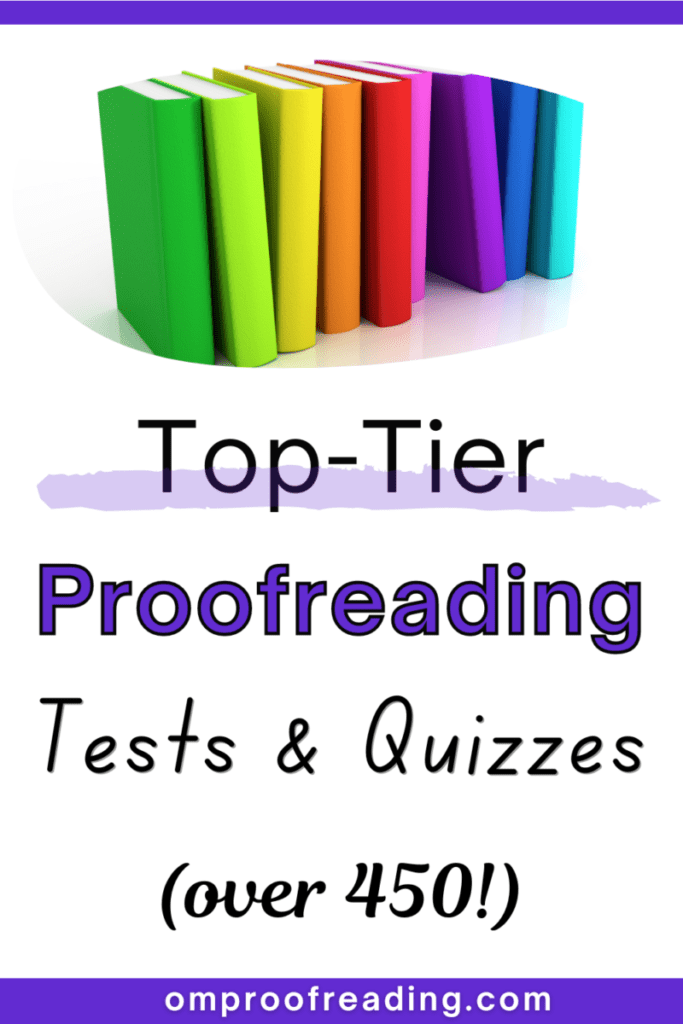
Lindsay Babcock
Lindsay is the creator of Om Proofreading. She has a BA in psychology and earned a certificate in proofreading by passing the final exam in Proofread Anywhere’s general proofreading course. She shares what she’s learning in the field and through research to inform and inspire her readers.
Recent Posts
6 Reasons Why Punctuation Is Important (with Examples)
Punctuation is important because it enables us to communicate our message clearly and effectively. Without punctuation, we wouldn’t understand how units of a sentence relate to one another or how...
What Is a Sentence Adverb? (+ Examples and a Quiz)
Although you're probably somewhat familiar with adverbs, you may be unaware of sentence adverbs. As a trained proofreader who has studied the parts of speech, I can help you understand this unique...
Reading Worksheets, Spelling, Grammar, Comprehension, Lesson Plans
Editing and Proofing Worksheets
A vital skill for young writers is to be able to revise and edit their writing. Recognizing an error in spelling, punctuation, grammar, and word usage takes some practice. The worksheets listed below give your student this important practice. You may use them for free in your classroom or at home. To read more about them or to download a printable PDF, simply click on the title. Check out all of our writing worksheets !
Make the Spelling Corrections
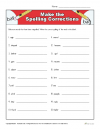
Encourage your students to look for spelling corrections with this “Correcting, Proofing, and Editing” worksheet.
Correct It!
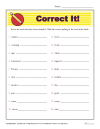
Use this “Correcting, Proofing, and Editing” activity to teach your students the importance of proofreading by correcting spelling mistakes.
Correct the Paragraph
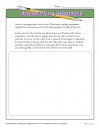
Have your students proofread and correct paragraphs with this helpful editing worksheet.
Correct the Spelling
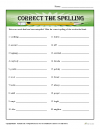
Teaching your students to correct spelling is made easier with this helpful, printable writing activity.
Correcting Mistakes: Rewrite the Sentences
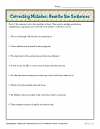
Encourage your students to check for sentence mistakes with this “Rewrite the Sentences” classroom activity.
Spot It: Unnecessary Words
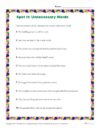
Practice identifying unnecessary words with this printable worksheet on editing and proofing. Students will be asked to read through a series of sentences and circle the ones that contain unnecessary words. This activity is great for use both at home and in the classroom.
Spot It! Faulty Coordination
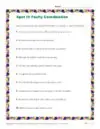
Help your students with their reading and writing skills by using this printable activity in class. With this worksheet on editing and proofing, students will be asked to read through ten sentences and identify the ones that contain faulty coordination. Ideal for 5th – 8th grade, but can be used where appropriate.
Correcting Mistakes in Sentences
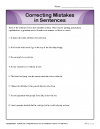
Use these printable learning materials to teach your students how to correct sentence mistakes.
Editing and Proofing a Paragraph
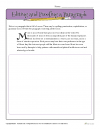
Your students will further their editing and proofing skills by correcting a paragraph in this printable classroom worksheet.
Find the Misplaced Modifiers
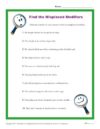
See if you can identify the other misplaced modifiers in this printable grammar worksheet. This grammar activity for middle school students is great for improving reading and writing skills. While it is ideal for 7th – 9th grade, it can be used where needed. This misplaced modifiers activity is perfect for both parents and teachers to use in the classroom or at home.
Spelling: What’s Wrong, and What’s Right?
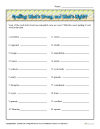
Your students will learn the difference between right and wrong in spelling with this “Proofing and Editing” worksheet.
Spot it! Which Are Grammatically Correct?
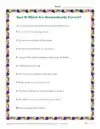
With this printable worksheet on editing and proofing, students will be asked to circle the number of the sentence that is grammatically correct. Ideal for 6th – 12th grade students, but can be used where needed.
Correct Spelling: Right or Wrong
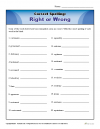
In this “Right or Wrong” classroom activity, your students will correct spelling mistakes while proofreading the sentences on this worksheet.
Find It! Faulty Parallel Construction
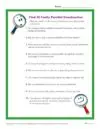
Practice recognizing faulty parallel construction by completing this printable worksheet. This activity focuses on refining editing and proofing skills. It is ideal for high school students, but can be used where appropriate. Because it is made easy to print, this worksheet is great for use both at home and in the classroom by parents, teachers, or students. Click the link below to download and print the worksheet to get started.
Paragraph: Proofing and Editing
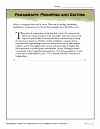
Use this “Printable Writing Worksheet” to help get in the routine of proofing and editing.

Editing and Proofreading
What this handout is about.
This handout provides some tips and strategies for revising your writing. To give you a chance to practice proofreading, we have left seven errors (three spelling errors, two punctuation errors, and two grammatical errors) in the text of this handout. See if you can spot them!
Is editing the same thing as proofreading?
Not exactly. Although many people use the terms interchangeably, editing and proofreading are two different stages of the revision process. Both demand close and careful reading, but they focus on different aspects of the writing and employ different techniques.
Some tips that apply to both editing and proofreading
- Get some distance from the text! It’s hard to edit or proofread a paper that you’ve just finished writing—it’s still to familiar, and you tend to skip over a lot of errors. Put the paper aside for a few hours, days, or weeks. Go for a run. Take a trip to the beach. Clear your head of what you’ve written so you can take a fresh look at the paper and see what is really on the page. Better yet, give the paper to a friend—you can’t get much more distance than that. Someone who is reading the paper for the first time, comes to it with completely fresh eyes.
- Decide which medium lets you proofread most carefully. Some people like to work right at the computer, while others like to sit back with a printed copy that they can mark up as they read.
- Try changing the look of your document. Altering the size, spacing, color, or style of the text may trick your brain into thinking it’s seeing an unfamiliar document, and that can help you get a different perspective on what you’ve written.
- Find a quiet place to work. Don’t try to do your proofreading in front of the TV or while you’re chugging away on the treadmill. Find a place where you can concentrate and avoid distractions.
- If possible, do your editing and proofreading in several short blocks of time. Your concentration may start to wane if you try to proofread the entire text at one time.
- If you’re short on time, you may wish to prioritize. Make sure that you complete the most important editing and proofreading tasks.
Editing is what you begin doing as soon as you finish your first draft. You reread your draft to see, for example, whether the paper is well-organized, the transitions between paragraphs are smooth, and your evidence really backs up your argument. You can edit on several levels:
Have you done everything the assignment requires? Are the claims you make accurate? If it is required to do so, does your paper make an argument? Is the argument complete? Are all of your claims consistent? Have you supported each point with adequate evidence? Is all of the information in your paper relevant to the assignment and/or your overall writing goal? (For additional tips, see our handouts on understanding assignments and developing an argument .)
Overall structure
Does your paper have an appropriate introduction and conclusion? Is your thesis clearly stated in your introduction? Is it clear how each paragraph in the body of your paper is related to your thesis? Are the paragraphs arranged in a logical sequence? Have you made clear transitions between paragraphs? One way to check the structure of your paper is to make a reverse outline of the paper after you have written the first draft. (See our handouts on introductions , conclusions , thesis statements , and transitions .)
Structure within paragraphs
Does each paragraph have a clear topic sentence? Does each paragraph stick to one main idea? Are there any extraneous or missing sentences in any of your paragraphs? (See our handout on paragraph development .)
Have you defined any important terms that might be unclear to your reader? Is the meaning of each sentence clear? (One way to answer this question is to read your paper one sentence at a time, starting at the end and working backwards so that you will not unconsciously fill in content from previous sentences.) Is it clear what each pronoun (he, she, it, they, which, who, this, etc.) refers to? Have you chosen the proper words to express your ideas? Avoid using words you find in the thesaurus that aren’t part of your normal vocabulary; you may misuse them.
Have you used an appropriate tone (formal, informal, persuasive, etc.)? Is your use of gendered language (masculine and feminine pronouns like “he” or “she,” words like “fireman” that contain “man,” and words that some people incorrectly assume apply to only one gender—for example, some people assume “nurse” must refer to a woman) appropriate? Have you varied the length and structure of your sentences? Do you tends to use the passive voice too often? Does your writing contain a lot of unnecessary phrases like “there is,” “there are,” “due to the fact that,” etc.? Do you repeat a strong word (for example, a vivid main verb) unnecessarily? (For tips, see our handouts on style and gender-inclusive language .)
Have you appropriately cited quotes, paraphrases, and ideas you got from sources? Are your citations in the correct format? (See the UNC Libraries citation tutorial for more information.)
As you edit at all of these levels, you will usually make significant revisions to the content and wording of your paper. Keep an eye out for patterns of error; knowing what kinds of problems you tend to have will be helpful, especially if you are editing a large document like a thesis or dissertation. Once you have identified a pattern, you can develop techniques for spotting and correcting future instances of that pattern. For example, if you notice that you often discuss several distinct topics in each paragraph, you can go through your paper and underline the key words in each paragraph, then break the paragraphs up so that each one focuses on just one main idea.
Proofreading
Proofreading is the final stage of the editing process, focusing on surface errors such as misspellings and mistakes in grammar and punctuation. You should proofread only after you have finished all of your other editing revisions.
Why proofread? It’s the content that really matters, right?
Content is important. But like it or not, the way a paper looks affects the way others judge it. When you’ve worked hard to develop and present your ideas, you don’t want careless errors distracting your reader from what you have to say. It’s worth paying attention to the details that help you to make a good impression.
Most people devote only a few minutes to proofreading, hoping to catch any glaring errors that jump out from the page. But a quick and cursory reading, especially after you’ve been working long and hard on a paper, usually misses a lot. It’s better to work with a definite plan that helps you to search systematically for specific kinds of errors.
Sure, this takes a little extra time, but it pays off in the end. If you know that you have an effective way to catch errors when the paper is almost finished, you can worry less about editing while you are writing your first drafts. This makes the entire writing proccess more efficient.
Try to keep the editing and proofreading processes separate. When you are editing an early draft, you don’t want to be bothered with thinking about punctuation, grammar, and spelling. If your worrying about the spelling of a word or the placement of a comma, you’re not focusing on the more important task of developing and connecting ideas.
The proofreading process
You probably already use some of the strategies discussed below. Experiment with different tactics until you find a system that works well for you. The important thing is to make the process systematic and focused so that you catch as many errors as possible in the least amount of time.
- Don’t rely entirely on spelling checkers. These can be useful tools but they are far from foolproof. Spell checkers have a limited dictionary, so some words that show up as misspelled may really just not be in their memory. In addition, spell checkers will not catch misspellings that form another valid word. For example, if you type “your” instead of “you’re,” “to” instead of “too,” or “there” instead of “their,” the spell checker won’t catch the error.
- Grammar checkers can be even more problematic. These programs work with a limited number of rules, so they can’t identify every error and often make mistakes. They also fail to give thorough explanations to help you understand why a sentence should be revised. You may want to use a grammar checker to help you identify potential run-on sentences or too-frequent use of the passive voice, but you need to be able to evaluate the feedback it provides.
- Proofread for only one kind of error at a time. If you try to identify and revise too many things at once, you risk losing focus, and your proofreading will be less effective. It’s easier to catch grammar errors if you aren’t checking punctuation and spelling at the same time. In addition, some of the techniques that work well for spotting one kind of mistake won’t catch others.
- Read slow, and read every word. Try reading out loud , which forces you to say each word and also lets you hear how the words sound together. When you read silently or too quickly, you may skip over errors or make unconscious corrections.
- Separate the text into individual sentences. This is another technique to help you to read every sentence carefully. Simply press the return key after every period so that every line begins a new sentence. Then read each sentence separately, looking for grammar, punctuation, or spelling errors. If you’re working with a printed copy, try using an opaque object like a ruler or a piece of paper to isolate the line you’re working on.
- Circle every punctuation mark. This forces you to look at each one. As you circle, ask yourself if the punctuation is correct.
- Read the paper backwards. This technique is helpful for checking spelling. Start with the last word on the last page and work your way back to the beginning, reading each word separately. Because content, punctuation, and grammar won’t make any sense, your focus will be entirely on the spelling of each word. You can also read backwards sentence by sentence to check grammar; this will help you avoid becoming distracted by content issues.
- Proofreading is a learning process. You’re not just looking for errors that you recognize; you’re also learning to recognize and correct new errors. This is where handbooks and dictionaries come in. Keep the ones you find helpful close at hand as you proofread.
- Ignorance may be bliss, but it won’t make you a better proofreader. You’ll often find things that don’t seem quite right to you, but you may not be quite sure what’s wrong either. A word looks like it might be misspelled, but the spell checker didn’t catch it. You think you need a comma between two words, but you’re not sure why. Should you use “that” instead of “which”? If you’re not sure about something, look it up.
- The proofreading process becomes more efficient as you develop and practice a systematic strategy. You’ll learn to identify the specific areas of your own writing that need careful attention, and knowing that you have a sound method for finding errors will help you to focus more on developing your ideas while you are drafting the paper.
Think you’ve got it?
Then give it a try, if you haven’t already! This handout contains seven errors our proofreader should have caught: three spelling errors, two punctuation errors, and two grammatical errors. Try to find them, and then check a version of this page with the errors marked in red to see if you’re a proofreading star.
Works consulted
We consulted these works while writing this handout. This is not a comprehensive list of resources on the handout’s topic, and we encourage you to do your own research to find additional publications. Please do not use this list as a model for the format of your own reference list, as it may not match the citation style you are using. For guidance on formatting citations, please see the UNC Libraries citation tutorial . We revise these tips periodically and welcome feedback.
Especially for non-native speakers of English:
Ascher, Allen. 2006. Think About Editing: An ESL Guide for the Harbrace Handbooks . Boston: Wadsworth Cengage Learning.
Lane, Janet, and Ellen Lange. 2012. Writing Clearly: Grammar for Editing , 3rd ed. Boston: Heinle.
For everyone:
Einsohn, Amy. 2011. The Copyeditor’s Handbook: A Guide for Book Publishing and Corporate Communications , 3rd ed. Berkeley: University of California Press.
Lanham, Richard A. 2006. Revising Prose , 5th ed. New York: Pearson Longman.
Tarshis, Barry. 1998. How to Be Your Own Best Editor: The Toolkit for Everyone Who Writes . New York: Three Rivers Press.
You may reproduce it for non-commercial use if you use the entire handout and attribute the source: The Writing Center, University of North Carolina at Chapel Hill
Make a Gift
Have a language expert improve your writing
Run a free plagiarism check in 10 minutes, generate accurate citations for free.
- Knowledge Base
- Language rules
Quick Guide to Proofreading | What, Why and How to Proofread
Published on June 21, 2019 by Shona McCombes . Revised on December 11, 2023.
Proofreading means carefully checking for errors in a text before it is published or shared. It is the very last stage of the writing process , when you fix minor spelling and punctuation mistakes, typos, formatting issues and inconsistencies.
Proofreading is essential for any text that will be shared with an audience, whether it’s an academic paper, a job application, an online article, or a print flyer. Depending on your skills and budget, you can choose to proofread the text yourself, use an AI proofreader , or hire a professional.
Instantly correct all language mistakes in your text
Upload your document to correct all your mistakes in minutes

Table of contents
Proofreading example, proofreading vs editing, proofreading tips and tricks, choosing a proofreading service, recommended proofreading service, frequently asked questions about proofreading.
In the publishing industry, proofreaders usually check a printed “proof copy” of the text and mark corrections using specialized proofreading marks. In other fields, though, professional proofreaders often work with digital texts and make corrections directly using the track changes feature in Microsoft Word or Google Docs.
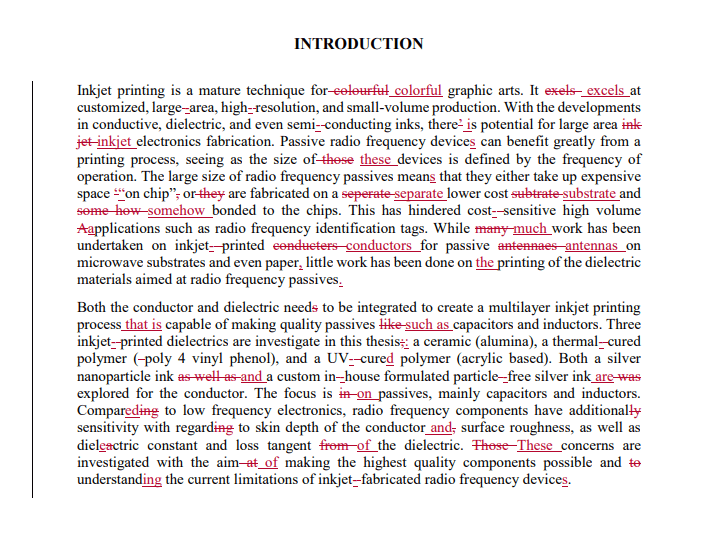
Check for common mistakes
Use the best grammar checker available to check for common mistakes in your text.
Fix mistakes for free
Editing and proofreading are different steps in the process of revising a text. Editing can involve major changes to content, structure and language, but proofreading focuses only on minor errors and inconsistencies.
Often a text will go through several stages of editing before it is proofread. The table below shows some common steps in the editing process.
The four stages of editing and proofreading
Do i need to go through every stage.
It depends on the type and length of text. You don’t need to strictly follow the division of tasks shown above, but a good piece of writing will nearly always go through a similar process of revising, editing and proofreading.
In the traditional publishing process, the stages are clearly divided, with different professionals responsible for each revision. A separate proofread of the final print version is necessary, especially because new typographical errors can be introduced during production.
However, in texts that don’t need to be formatted for mass printing, there is often more overlap between the steps. Some editorial services combine copy editing and proofreading into a single stage (sometimes called proof-editing), where grammar, syntax and style are addressed at the same time as minor spelling and punctuation errors (e.g., commas , quotation marks and parentheses ).
Basic proofreading skills are important for anyone who writes. For everyday texts, such as business reports, blogs, or college papers, there are some techniques you can use to proofread efficiently and effectively before sharing your work.
Edit your writing first
Before you get to the final stage of proofreading, make sure you’ve thoroughly revised and edited your work. There’s no point spending time fixing minor errors if you might later remove whole sections or rewrite paragraphs. Only proofread once you’ve got a completed final draft that you’re happy with.
Take a break from the text
When you’ve been reading and rereading the same words for hours or days, it becomes much harder to notice common mistakes . Before proofreading, set your work aside for a while so that you can look at it with fresh eyes.
Ideally you should wait at least a day or two before final proofreading, but if you’re on a tight deadline, even a half hour break can help.
Proofread a printout
Seeing your words on a printed page is another useful strategy for noticing things that might have escaped your attention on the screen. If the final version will be printed, this is also a good chance to check your formatting is correct and consistent on the page.
Use digital shortcuts
While reading from print can help you spot errors, an online proofreader can help you fix them efficiently. Most obviously, run a spell check—but don’t rely on the computer to catch every mistake.
If you notice that you’ve repeatedly misspelled a particular word, inconsistently capitalized a term, or switched between UK and US English , you can use the Find and Replace function to fix the same mistake throughout the document.
Be careful, though, and don’t use “replace all”. Click through and check every replacement to avoid accidentally adding more errors!
Learn from your mistakes
Pay attention to the errors that keep recurring in the text. This can help you avoid them in future.
Knowing what to look out for is the most challenging part of proofreading. You’ll probably notice obvious typos, but subtle mistakes in grammar and punctuation can be harder to recognize. The table below shows some of the most common errors to look out for.
What to watch out for when proofreading
If you lack confidence in your written English, or if you just want to ensure you haven’t missed anything in an important document, you might want to consider using a professional proofreading service.
There are two main options: you can hire a freelance proofreader, or you can send your document to a proofreading and editing company. There are various things to consider when choosing a service.
Do you only need proofreading or also editing?
It’s important to have a clear idea of how much work your text requires. People often think they only need proofreading when, in reality, the text would benefit from some level of editing as well.
If you send a proofreader a document full of grammar mistakes, confusing sentences, and difficult-to-follow paragraphs, they might decline the job or recommend a different service.
Many freelancers and companies offer both editing and proofreading, either separately (with separate pricing) or combined into one service. Make sure you understand exactly what kind of changes are included. Will the editor only correct minor errors, or will they also comment on awkward phrasings and structural issues?
Should the proofreader be specialized in your type of document?
Many different types of documents require proofreading: from literary novels to technical reports, from PhD dissertations to promotional flyers . The best choice of service is usually one that’s specialized in your type of document.
While proofreaders and copy editors generally don’t need expert knowledge of the text’s content, the process will be smoother if your proofreader is familiar with the rules and conventions of the genre you’re working in.
How much does proofreading cost?
The cost of proofreading varies widely. The price depends partly on the proofreader’s location and level of experience, the type and length of text, and the turnaround time. Rates are usually calculated per word or per hour. If the service also focuses on formatting, it may be priced per page.
How long does proofreading take?
You should try to leave plenty of time for editing and proofreading, but if you have a hard deadline, it’s important to find a service that can deliver on time.
Most companies offer various choices of deadline, but it’s best to plan a minimum of 24 hours for proofreading. The price will generally be lower if you can wait longer to have your document returned.
For very long documents, it might not be possible to complete the job in 24 hours, especially if you also need editing services. For combined proofreading and copy editing, you can expect an experienced editor to complete around 10,000–15,000 words in a single day.
How can you check the quality and reliability of the service?
Like everything on the internet, the quality of proofreading services varies widely. Do your research before you choose one. There are a few things you can check:
- Online reviews : are they rated on independent review sites (e.g., Trustpilot ) or freelancer platforms (e.g., Upwork )?
- Qualifications : do they have professional training and experience? If you’re using a company, how do they select and train proofreaders?
- Customer service : are they easily contactable and responsive to inquiries?
- Complaints policy : what happens if you’re not happy with the job? Can you get a refund or a second edit?
The only proofreading tool specialized in correcting academic writing - try for free!
The academic proofreading tool has been trained on 1000s of academic texts and by native English editors. Making it the most accurate and reliable proofreading tool for students.

Try for free
Scribbr offers proofreading services for students and academic editing services for all sorts of study-related documents, including essays, papers, theses, dissertations, reports, and proposals.
The basic service combines proofreading and copy editing at a rate of $0.017 per word. You can choose between a 24-hour, 3-day, or 7-day turnaround time.
Scribbr is rated 4.6 on Trustpilot, with 3,558 reviews so far.
Editing and proofreading are different steps in the process of revising a text.
Editing comes first, and can involve major changes to content, structure and language. The first stages of editing are often done by authors themselves, while a professional editor makes the final improvements to grammar and style (for example, by improving sentence structure and word choice ).
Proofreading is the final stage of checking a text before it is published or shared. It focuses on correcting minor errors and inconsistencies (for example, in punctuation and capitalization ). Proofreaders often also check for formatting issues, especially in print publishing.
Whether you’re publishing a blog, submitting a research paper , or even just writing an important email, there are a few techniques you can use to make sure it’s error-free:
- Take a break : Set your work aside for at least a few hours so that you can look at it with fresh eyes.
- Proofread a printout : Staring at a screen for too long can cause fatigue – sit down with a pen and paper to check the final version.
- Use digital shortcuts : Take note of any recurring mistakes (for example, misspelling a particular word, switching between US and UK English , or inconsistently capitalizing a term), and use Find and Replace to fix it throughout the document.
If you want to be confident that an important text is error-free, it might be worth choosing a professional proofreading service instead.
The cost of proofreading depends on the type and length of text, the turnaround time, and the level of services required. Most proofreading companies charge per word or page, while freelancers sometimes charge an hourly rate.
For proofreading alone, which involves only basic corrections of typos and formatting mistakes, you might pay as little as $0.01 per word, but in many cases, your text will also require some level of editing , which costs slightly more.
It’s often possible to purchase combined proofreading and editing services and calculate the price in advance based on your requirements.
There are many different routes to becoming a professional proofreader or editor. The necessary qualifications depend on the field – to be an academic or scientific proofreader, for example, you will need at least a university degree in a relevant subject.
For most proofreading jobs, experience and demonstrated skills are more important than specific qualifications. Often your skills will be tested as part of the application process.
To learn practical proofreading skills, you can choose to take a course with a professional organization such as the Society for Editors and Proofreaders . Alternatively, you can apply to companies that offer specialized on-the-job training programmes, such as the Scribbr Academy .
Cite this Scribbr article
If you want to cite this source, you can copy and paste the citation or click the “Cite this Scribbr article” button to automatically add the citation to our free Citation Generator.
McCombes, S. (2023, December 11). Quick Guide to Proofreading | What, Why and How to Proofread. Scribbr. Retrieved April 2, 2024, from https://www.scribbr.com/language-rules/what-is-proofreading/
Is this article helpful?
Shona McCombes
Other students also liked, punctuation in academic writing: common errors | examples, how to revise your college admissions essay | examples, "i thought ai proofreading was useless but..".
I've been using Scribbr for years now and I know it's a service that won't disappoint. It does a good job spotting mistakes”

IMAGES
VIDEO
COMMENTS
Find and correct errors in capitalization, spelling, punctuation, and grammar in short paragraphs. Download free printable worksheets for different grade levels and topics, such as sports, holidays, and animals.
Download 20 free proofreading exercises suitable for adults and children of all levels. Learn to proofread like a professional with the No-Nonsense Proofreading Course and its bonus eBooks and materials.
Find printable worksheets to help students learn and practice proofreading and editing skills. Correct errors, use editing marks, rewrite sentences, and more with these activities.
Learn how to proofread effectively with tips from experts and online resources. Find exercises and quizzes to test your skills and improve your editing knowledge.
Learn how to teach proofreading and editing skills to students of all ages with these fun and engaging activities. From online games to peer editing, from spelling to grammar, from basketball to the beach, find the perfect activity for your classroom.
Download each exercise PDF to get started, then print it out or copy-paste it into Microsoft Word; once you’ve finished editing, cross-check the mistakes you found with the relevant answer sheet. Good luck! Answer sheets follow AP Stylebook conventions (where appropriate) and use British spelling. New proofreading exercises will be regularly ...
I own and love this book! The site is a fantastic resource for proofreaders and copy editors as it teaches the rules for English grammar, punctuation, and usage. It includes 4 free tests and 52 free quizzes. Hundreds of additional quizzes are available with a paid subscription. Go to the Tests and Quizzes!
Use this “Printable Writing Worksheet” to help get in the routine of proofing and editing. Grade Levels: 9th - 12th Grade, Grades K-12. CCSS Code (s): W.9-10.5, W.11-12.5. The worksheets listed below give your student the important practice of proofing and editing their work. Click to view and print!
The proofreading process becomes more efficient as you develop and practice a systematic strategy. You’ll learn to identify the specific areas of your own writing that need careful attention, and knowing that you have a sound method for finding errors will help you to focus more on developing your ideas while you are drafting the paper.
Step 1: Content editing. Revising an early draft of a text, often making significant changes to the content and moving, adding or deleting entire sections (also known as developmental or substantive editing). Step 2: Line editing. Revising the use of language to communicate your story, ideas, or arguments as effectively as possible.